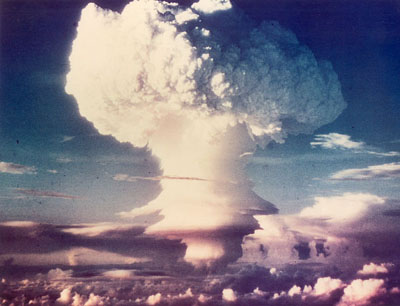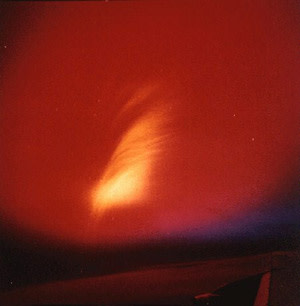Starfish Prime
On July 9, 1962 the United States detonated a nuclear weapon high above the Pacific Ocean. Designated Starfish Prime, it was part of a dangerous series of high-altitude nuclear bomb tests at the height of the Cold War. Its immediate effects were felt for thousands of kilometers, but it would also have a far-reaching aftermath that still touches us today.

The "Yankee" shot, 14 May 1954 (GMT), during the Castle series of nuclear weapons test in the South Pacific
In 1958, the Soviet Union called for a ban on atmospheric tests of nuclear weapons, and went so far as to unilaterally stop such testing. Under external political pressure, the US acquiesced. However, in late 1961 political pressures internal to the USSR forced Khrushchev to break the moratorium, and the Soviets began testing once again. So, again under pressure, the US responded with tests of their own.
It was a scary time to live in.
The US, worried that a Soviet nuclear bomb detonated in space could damage or destroy US intercontinental missiles, set up a series of high-altitude weapons tests called Project Fishbowl (itself part of the larger Operation Dominic) to find out for themselves what happens when nuclear weapons are detonated in space. High-altitude tests had been done before, but they were hastily set up and the results inconclusive. Fishbowl was created to take a more rigorous scientific approach.
On July 9, 1962, the US launched a Thor missile from Johnston island, an atoll about 1500 kilometers (900 miles) southwest of Hawaii. The missile arced up to a height of over 1100 km (660 miles), then came back down. At the preprogrammed height of 400 km (240 miles), just seconds after 09:00 UTC, the 1.4 megaton nuclear warhead detonated.
And all hell broke loose.
1.4 megatons is the equivalent of 1.4 million tons of TNT exploding. However, nuclear weapons are fundamentally different from simple chemical explosives. TNT releases its energy in the form of heat and light. Nukes also generate heat and light, plus vast amounts of X-rays and gamma rays – high-energy forms of light – as well as subatomic particles like electrons and heavy ions.
And all hell broke loose.
1.4 megatons is the equivalent of 1.4 million tons of TNT exploding. However, nuclear weapons are fundamentally different from simple chemical explosives. TNT releases its energy in the form of heat and light. Nukes also generate heat and light, plus vast amounts of X-rays and gamma rays – high-energy forms of light – as well as subatomic particles like electrons and heavy ions.
The glow of starfish airglow
One immediate effect of the blast was a huge aurora seen for thousands of kilometers around. Electrons are lightweight and travel rapidly away from the explosion. A moving electron is affected by a magnetic field, so these electrons actually flowed quickly along the Earth’s magnetic field lines and were dropped into the upper atmosphere. At a height of roughly 50 – 100 kilometers they were stopped by the atoms and molecules of Earth’s atmosphere. Those atoms and molecules absorbed the energy of the electrons and responded by glowing, creating an artificial aurora.
Heavy ions (atoms stripped of electrons) are also created in the blast, and get absorbed somewhat higher up in the atmosphere. The image here shows this glow as seen by an airplane moments after the nuclear explosion. The feathery filament is from the bomb debris, while the red glow may be due to glowing oxygen atoms; this tends to be from atoms higher than 100 km, so the glow is probably due to the heavy ions impacting our air.
The Electromagnetic Pulses
But the effects were far more than a simple light show. When the bomb detonated, those electrons underwent incredible acceleration. When that happens they create a brief but extremely powerful magnetic field. This is called an electromagnetic pulse, or EMP. The strength of the pulse was so huge that it affected the flow of electricity on the Earth hundreds of kilometers away! In Hawaii it blew out hundreds of streetlights, and caused widespread telephone outages. Other effects included electrical surges on airplanes and radio blackouts.
The EMP had been predicted by scientists, but the Starfish Prime pulse was far larger than expected. And there was another effect that hadn’t been predicted accurately. Many of the electrons from the blast didn’t fall down into the Earth’s atmosphere, but instead lingered in space for months, trapped by Earth’s magnetic field, creating an artificial radiation belt high above our planet’s surface.
When a high-speed electron hits a satellite, it can generate a sort-of miniature EMP. The details are complex, but the net effect is that these electrons can zap satellites and damage their electronics. The pulse of electrons from the Starfish Prime detonation damaged at least six satellites (including one Soviet bird), all of which eventually failed due to the blast. Other satellite failures at the time may be linked to the explosion as well.
The overall effect shocked scientists and engineers. They had expected something much smaller, not nearly the level that actually occurred. Because of this, later high-altitude nuclear tests made by the US as part of Operation Fishbowl were designed to have a much lower yield. Although the explosion energies are still classified, it’s estimated they ranged from a few dozen to a few hundred kilotons, a fraction of the 1.4 megaton Starfish Prime explosion.
Thank you reading and please share this blog
Have a nice day











0 comments:
Post a Comment
Comment for More